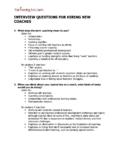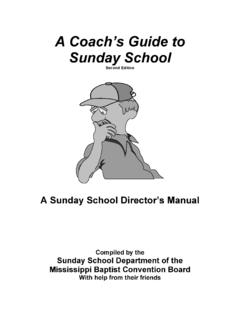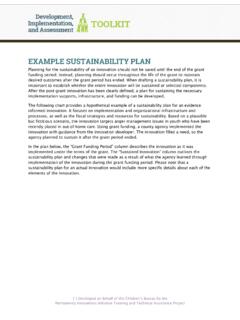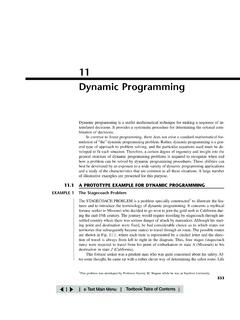Transcription of Building Trust in Teams: A Leader’s Role
1 Building Trust in Teams: A Leader s Role13 Building Trust in Teams: A Leader s Role 2013 IUP. All Rights Turaga* Building Trust in teams is one of the key aspects of learning takeawaythat every team Building workshop delivers, be it indoor or outdoor, oroutbound. The attitude and ability to Trust one another in a team isconsidered one of the most critical elements that help team members bondwith each other and work together seamlessly towards their common leaders of teams, every individual constantly looks for this trait intheir teams. However, just a few practice activities like Trust fall, obstaclepath, etc. in a workshop or the knowledge that Trust is essential may notbe enough for a team to have and work with that trait.
2 Apart from theseintermittent activities, leaders also need to consistently do their bit,day in and day out, to ensure that Trust gets built and stays in their paper introduces the concept of Trust in individuals and teams,describes the various steps that leaders need to take, and the techniquesthat they can apply at different stages of their teams to develop andmaintain Trust within them.*International Trainer and Leadership Coach, 14-324, Doyens Township, Opp. ALIND, Serilingampally,Hyderabad 500019, Andhra Pradesh, India. E-mail: leaders who work most effectively, it seems to me, never say I . And that snot because they have trained themselves not to say I.
3 They don t think I . Theythink we ; they think team . They understand their job to be to make the teamfunction. They accept responsibility and don t sidestep it, but we gets the is what creates Trust , what enables you to get the task done. Peter DruckerTrust in TeamsAs Harold Macmillan said, A man who trusts nobody is apt to be the kind of mannobody trusts. Trust is the foundation of every successful relationship, be it personalor professional. In organizations today where teams have to work together, it isimperative that employees Trust one a social context, Trust usually is referenced when one individual or party is willingto rely on the words or actions of the other individual or party and though not sureof the outcome of the actions, is willing to leave control to the other party knowingwell enough that the possible risks involve failure of the task or harm to self if thingsdo not go as trusted (Figure 1).
4 The IUP Journal of Soft Skills, Vol. VII, No. 2, 201314In fact, the Merriam-Webster dictionary defines Trust as the assured reliance on thecharacter, ability, strength or truth of someone or something, , the confidence thatis placed in : The Foundation of RelationshipsTrust is mainly attributed to relationships between people and amongst social is said that when an individual trusts another, s/he tends to expose certainvulnerabilities to the other person believing that they will not take advantage of theindividual s openness. Individuals in personal relationships such as friendships tomarriage to working together, tend to do just that to feel the other person is times, the other emotions that go hand in hand with Trust include friendship,love, agreement, peace of mind, comfort, and a time, with Trust as the foundation of the relationship, one tends to predictwhat the other can do even without knowing much about the other person or withoutmuch knowledge of the History of TrustPsychology studies state that to Trust is to believe that the other person will do whatis expected.
5 Erikson (1950), in his famous theory of eight stages of psycho-socialdevelopment, portrayed that how much an individual trusts another begins to form asa foundation right in the first two years of the person s childhood, , during infancyitself (Figure 2). In fact, Trust is also known to be neuro-biologically traced and connectedto the activity of the human brain and is altered or aligned with the levels of the chemicaloxytocin Building starts within the family, and then slowly as the child grows up, thefoundations traverse to the other social groups and this continues on over time. Everyexperience either increases or decreases the levels of Trust that one can place in others Figure 1: Risks in TrustSource: Trust in Teams: A Leader s Role15success leads to feelings of security, Trust , positivity and optimism, while failure resultsin a sense of insecurity and the early works of Luhmann (1979), Barber (1983), and Giddens (1984), trustis considered, in sociology, as one of the several social-constructs along with control,confidence, risk, power, etc.
6 It is considered an element of social reality and functionsbetween and amongst various social groups (Figure 3). In philosophy, Trust isconsidered more as a point of reliance and dependability. In economic terms, trustis often used as a lubricant to reduce the cost of transactions between parties byenabling , in general, Trust is a popular framework to create effective interpersonalrelationships. A trustworthy person is usually someone in whom one can place theirtrust and remain assured that the Trust will not be betrayed by the other the above in mind, many a time individuals tend to ask themselves a lot ofquestions with regard to Trust What is Trust ?
7 How do I decide that I will Trust someone?Figure 3: Trust in Social GroupsSource: 2: Trust Building in ChildhoodSource: IUP Journal of Soft Skills, Vol. VII, No. 2, 201316Am I just convincing myself or can I really Trust this person for sure? How do we decideif enough time has passed to be able to easily Trust someone? How do I ensure thatI can be trusted, that others can call me trustworthy? Not only individuals struggle toanswer these questions, so do in OrganizationsThe dynamics of Trust -mistrust in an organization can make or break the culture andbond in an organization. There can be nothing more damaging than a lack of trustbetween the employees of an organization.
8 Lack of Trust can create a hostile environmentthat can be toxic to several people and other teams around them. So, what does trustmean in an organization?The International Association of Business Communicators (IABC) defines Trust inan organization as, The organization s willingness, based upon its culture andcommunication behaviors in relationships and transactions, to be open and honest,based on belief that another individual, group, or organization is also competent, openand honest, concerned, reliable, and identified with common goals, norms andvalues. IABC also, as an organization, funds and conducts surveys to measure theOrganizational Trust Index (Figure 4) which gives us not only research findings aboutthe importance of organizational Trust but also, more importantly, a tool to measure trustin an organization.
9 It is said that there are five dimensions that create organizationaltrust, which statistically increase job satisfaction as well as comfort Covey (2006), in his book, Speed of Trust , describes Trust existing in anorganization as confidence, and the lack of Trust as suspicion in people, their abilitiesFigure 4: Measuring Trust in OrganizationsSource: Trust in Teams: A Leader s Role17 Why Should Leaders Focus on Trust ?Leadership, in the context of today s organizations is not just about having a vision,setting huge targets, and creating strategies to reach there. Yes, these are all still verymuch in the purview of leadership. However, along with these, in order to succeed,leaders also need to focus all their energies on Building synergy amongst their teammembers.
10 There are many workshops and books that talk and teach the various skillsthat leaders need to learn and apply in order to effectively manage their teams. Theseskills range from listening and coaching and mentoring to effective delegation andconflict resolution. One factor however, which forms one of the key parameters thathold teams together, is a sense of belongingness, a sense of being one with theorganization, of bonding with each other in short, team members need to be able totrust one another. It is thus critical for a leader today to learn the appropriate actionsfrom his/her side that will help build, maintain and sustain these bonds of Trust , whichin turn will thrust the team are many books and programs and frameworks on how to build Trust , andwhat leaders need to do to create the culture of Trust in their from Gary Cohen s 7Cs of Trust that are taught in many workshops(Figure 6), in fact, Robert Shaw (1997) in his book, Trust in the Balance, describes threekey elements to build Trust : (1) Achieving results (leadership needs to fulfil theircommitments).





